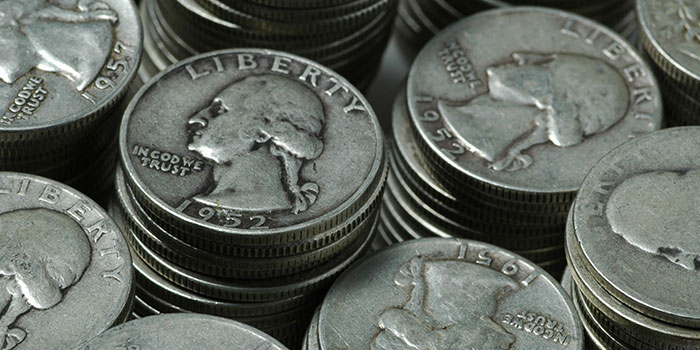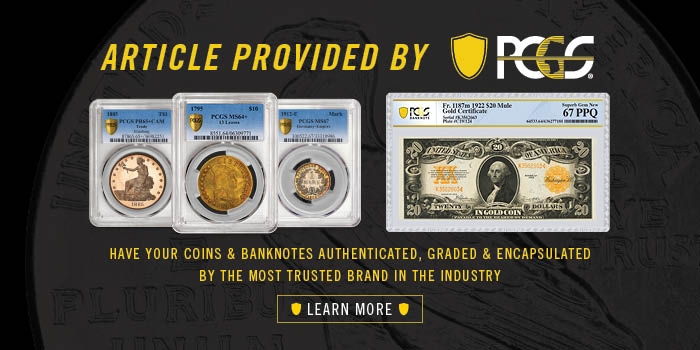
By Victor Bozarth for PCGS ……
One of the biggest volume purchases in most coin shops is that of pre-1965 90% silver U.S. coinage. Depending on the prevailing winds of the bullion markets, the volume (both bought and sold) can be a proverbial trickle or metaphorical flood. The silver price itself is usually a good indicator of volume. If the price for silver is high, usually the volume increases.
There have been several strong silver markets over the last five decades. Because 90% silver coinage is a popular item generally sold in face value (“FV”) quantity, an accurate count is vital. Not only are many shops equipped with mechanical coin counters, but some bigger shops have both computerized counting machines and current bid and ask prices posted on a digital bulletin board.
Early coin-counting devices were purely mechanical with a hand crank on the side. Today’s models are computerized and even count and sort different denominations. The basic principle is for both the dealer and customer to have an accurate count to consummate the deal. Hand counts are often wrong, and the time involved is cost-prohibitive.
All of this is straightforward, but how do you make sure you’re only counting 90% silver coinage? When using a coin counter, how do you detect those coins that are not 90% silver?
Often, clad and 40% silver coinage is mixed in with the 90% silver. Clad coinage is obvious with the sandwich-metal appearance easily visible on the edge of the coin. The time involved to inspect each coin is often inhibitory cost-wise. But, what do you do with those 40% silver coins lacking the apparent orange edge ring most associated with copper-nickel clad coins? You can sort them by date, e.g. 1965 to 1969 Kennedy half dollars are 40% silver and do not have the distinctive sandwich-edge look.
One of the tools some dealers use to catch clad coinage (in their 90% silver counts) is aural resonance. Silver rings, while clad coins click. The resonance of the silver versus that of a clad coin going through a counter is distinctive to the machine being used. Not only do different silver denominations have a different ring, but 40% silver halves ring with a slightly different resonance. Clad coins click! The distinctive difference between the flat tone click of a clad coin versus the melodious ring of silver coins is quite different. Silver coins ring!
That distinctive difference in the resonance can be quite an asset to a dealer or collector. Clad coins that make a clicking sound are usually worth face value and carry no premium. Silver coins that ring generally carry a premium. Additionally, this resonance can be quite helpful when looking at a coin that is not clearly identifiable as far as the type of metal used. Generally, if a pre-1965 silver coin clicks, its authenticity is questionable.
I learned the silver resonance (or “ring”) trick early in my collecting career. I was sorting through a dealer’s bargain (“junk”) box and pulled out a coin I knew was worth a lot more than the “Two for $1” price written on the side of the box. I was in my early teens, and the nuances of most counterfeit coins were still a mystery to me. But, I knew at almost a gut level that something was wrong/bad/off about this bargain. I can’t remember the date or type of coin, but when I set the coin on top of the dealer’s showcase, it didn’t ring. I put the coin back and thanked the dealer for allowing me to look.
Later that evening, one of my dealer mentors named Bud Benson from the Kansas City area explained the ring or resonance trick. Of course, this isn’t really a trick at all – it’s just another example of how knowledge is king in any business. In the years since I’ve often used this tool to avoid problem/counterfeit coins.
In my travels buying coins, I’ve visited hundreds of shops in almost all 50 states – yes, Hawaii and Alaska, too. Many dealers don’t have the luxury of show travel because they are always too busy in their stores to attend shows. While being a shop owner might mean not having the trading experience or exposure of a dealer who attends the major shows, I’ve learned to never underestimate anyone’s numismatic knowledge. Some of the best scholars in numismatics are limited in their travels. Before the internet, numismatic knowledge was harder to come by. Published material was limited. Reference books and numismatic periodicals were often not available to anyone but those in larger markets. Back in the day, you had to subscribe, buy, or, if possible, try to borrow coin reference material.
Public libraries had few actual coin reference books or magazines. I know. During my travels as a kid and young man, I would always visit the local library, check their reference card file, and even ask the librarian if they had any coin books or magazines. I learned that my inquiring about numismatics did nothing but confuse most librarians.
Some of the more impressive and memorable lessons I’ve learned in shops include applying the resonance trick. A shop in the Upper Midwest was a destination I tried to visit several times a year, depending on my schedule. This shop is a full-service coin store that not only bought and sold coins, but also had a substantial bullion/scrap business. Over a couple of years of visits to this shop, I became more well acquainted with some of the employees. I always keep my ears open at any coin venue. It’s amazing what you learn when you shut your mouth and open your ears. While flipping through this shop’s inventory during my visits, I also paid attention to what was going on in the shop. Because this shop did substantial bullion business, the counting machine was almost always being used.
The first couple of times I saw this dealer stop the machine in the middle of a count, I wasn’t aware of what he was doing. After several visits and this stopping of the counting machine fairly often, I realized what he was doing.
Some of us don’t have the ear for it. Yet, this dealer and others I’ve met through the years can distinguish the difference in the resonance of the coins being counted. Not only are they able to hear when a coin being counted clicks (clad coin=face value), but even more impressive is the ability to identify from the resonance the difference between 40% and 90% silver halves.
In other words, I’ve encountered dealers who can hear a clad coin going through the machine as well as distinguish the difference between 40% and 90% silver halves. Dealers address the issue by immediately stopping the machine and examining the latest coins to be counted. Most often the culprit is still on top of those already counted. The clad and 40% silver is removed from the bag, the count is adjusted, and the transaction figures are accurate. Especially with volatile silver prices and the small profit margins on most bullion transactions dealers must pay attention.
* * *






I have 1958 Kennedy what is value
Please check that date again. JFK was a senator in 1958 and very much alive so he wouldn’t have been on a coin.
Whenever you have questions about a coin’s value you need to provide not just its date but its denomination and mint mark. Further, there are many sites that specialize in listing values. This site is primarily a news site, rather than a “what’s it worth” reference.
I’ll appraise your 1958 Kennedy Half Dollar for you free of charge.
Please post a photo of it here.
As noted, there is no such coin.
The original poster has either misread the date or mistaken Benjamin Franklin for JFK. Without knowing which, it’s not possible to give a value.